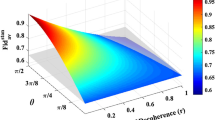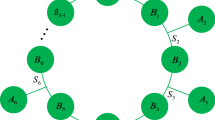Abstract
Quantum teleportation1,2,3,4,5,6,7,8 involves the transportation of an unknown quantum state from one location to another, without physical transfer of the information carrier. Although quantum teleportation is a naturally bipartite process, it can be extended to a multipartite protocol known as a quantum teleportation network9. In such a network, entanglement is shared between three or more parties. For the case of three parties (a tripartite network), teleportation of a quantum state can occur between any pair, but only with the assistance of the third party. Multipartite quantum protocols are expected to form fundamental components for larger-scale quantum communication and computation10,11. Here we report the experimental realization of a tripartite quantum teleportation network for quantum states of continuous variables (electromagnetic field modes). We demonstrate teleportation of a coherent state between three different pairs in the network, unambiguously demonstrating its tripartite character.



Similar content being viewed by others
References
Bennett, C. H. et al. Teleporting an unknown quantum state via dual classical and Einstein-Podolsky-Rosen channels. Phys. Rev. Lett. 70, 1895–1899 (1993)
Bouwmeester, D. et al. Experimental quantum teleportation. Nature 390, 575–579 (1997)
Boschi, D., Branca, S., De Martini, F., Hardy, L. & Popescu, S. Experimental realization of teleporting an unknown pure quantum state via dual classical and Einstein-Podolsky-Rosen channels. Phys. Rev. Lett 80, 1121–1125 (1998)
Nielsen, M. A., Knill, E. & Laflamme, R. Complete quantum teleportation using nuclear magnetic resonance. Nature 396, 52–55 (1998)
Marcikic, I., De Riedmatten, H., Tittel, W., Zbinden, H. & Gisin, N. Long-distance teleportation of qubits at telecommunication wavelengths. Nature 421, 509–513 (2003)
Furusawa, A. et al. Unconditional quantum teleportation. Science 282, 706–709 (1998)
Bowen, W. P. et al. Experimental investigation of continuous-variable quantum teleportation. Phys. Rev. A 67, 032302 (2003)
Zhang, T. C., Goh, K. W., Chou, C. W., Lodahl, P. & Kimble, H. J. Quantum teleportation of light beams. Phys. Rev. A 67, 033802 (2003)
van Loock, P. & Braunstein, S. L. Multipartite entanglement for continuous variables: A quantum teleportation network. Phys. Rev. Lett. 84, 3482–3485 (2000)
Nielsen, M. A. & Chuang, I. L. Quantum Computation and Quantum Information (Cambridge Univ. Press, Cambridge, 2000)
Braunstein, S. L. & Pati, A. K. Quantum Information with Continuous Variables (Kluwer Academic, Dordrecht, 2003)
Aoki, T. et al. Experimental creation of a fully inseparable tripartite continuous-variable state. Phys. Rev. Lett. 91, 080404 (2003)
Greenberger, D. M., Horne, M. A., Shimony, A. & Zeilinger, A. Bell's theorem without inequalities. Am. J. Phys. 58, 1131–1143 (1990)
Dür, W., Vidal, G. & Cirac, J. I. Three qubits can be entangled in two inequivalent ways. Phys. Rev. A 62, 062314 (2000)
van Loock, P. & Furusawa, A. Detecting genuine multipartite continuous-variable entanglement. Phys. Rev. A 67, 052315 (2003)
Jing, J. et al. Experimental demonstration of tripartite entanglement and controlled dense coding for continuous variables. Phys. Rev. Lett. 90, 167903 (2003)
Braunstein, S. L. & Kimble, H. J. Teleportation of continuous quantum variables. Phys. Rev. Lett. 80, 869–872 (1998)
Braunstein, S. L., Fuchs, C. A. & Kimble, H. J. Criteria for continuous-variable quantum teleportation. J. Mod. Opt. 47, 267–278 (2000)
Braunstein, S. L., Fuchs, C. A., Kimble, H. J. & Loock, P. Quantum versus classical domains for teleportation with continuous variables. Phys. Rev. A 64, 022321 (2001)
van Loock, P. & Braunstein, S. L. Telecloning of continuous quantum variables. Phys. Rev. Lett. 87, 247901 (2001)
Acknowledgements
This work was partly supported by the MEXT and the MPHPT of Japan, and the Research Foundation for Opto-Science and Technology.
Author information
Authors and Affiliations
Corresponding author
Ethics declarations
Competing interests
The authors declare that they have no competing financial interests.
Rights and permissions
About this article
Cite this article
Yonezawa, H., Aoki, T. & Furusawa, A. Demonstration of a quantum teleportation network for continuous variables. Nature 431, 430–433 (2004). https://doi.org/10.1038/nature02858
Received:
Accepted:
Issue Date:
DOI: https://doi.org/10.1038/nature02858
- Springer Nature Limited
This article is cited by
-
Demonstration of controlled high-dimensional quantum teleportation
Science China Physics, Mechanics & Astronomy (2024)
-
Continuous variable quantum teleportation and remote state preparation between two space-separated local networks
Science China Information Sciences (2024)
-
Enhancing quantum teleportation efficacy with noiseless linear amplification
Nature Communications (2023)
-
Correlated Effects of Pauli Noise on Controlled Teleportation of an Arbitrary Single-Qubit State Via a Three-Qubit W State
International Journal of Theoretical Physics (2023)
-
Demonstration of fully-connected quantum communication network exploiting entangled sideband modes
Frontiers of Physics (2023)





